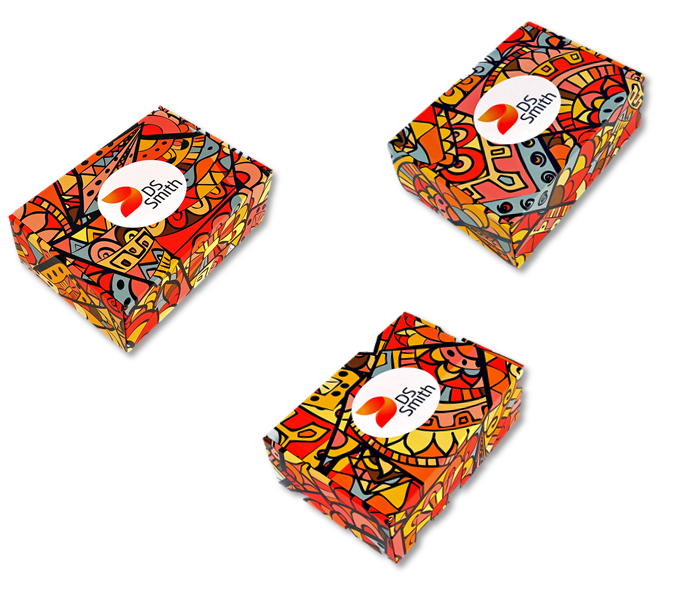Anja Roehrle, marketing and communication manager at DS Smith, and writing for the drupa Essentials of Print series, states that the packaging industry has a lot to offer when it comes to e-commerce packaging made of corrugated board, with innovative solutions and state-of-the-art print technologies.
Digital pre-print opens a new era for brand protection and brand activation in e-commerce. Smart, digitally printed corrugated cardboard packaging solutions inform, entertain and network the shopper. They warn of product counterfeiting and guarantee transparency in shipment and traceability. All this is now possible not only for short, but also for medium and long print runs. Hence, there is almost a paradox: that of individualised mass production.
The ongoing digitalisation and the associated changes in consumer shopping behaviour have a major impact on the design and construction of packaging. Mass-produced products lose their attractiveness. Brand manufacturers, retailers and logistics providers are adapting to the new challenges of online trading. They receive strong impetus from the packaging industry, which has a lot to offer when it comes to e-commerce packaging made of corrugated board, with innovative solutions and state-of-the-art print technologies.
74.4 billion: this is the number of shipments that courier, express and parcel (CEP) services carried worldwide in 2017, according to the latest figures in the annual Pitney Bows Parcel Shipping Index. This is roughly 17 percent more than in the previous year. This surge in parcel volume is being fuelled by the continuing boom in e-commerce. Already by 2020, it is expected to exceed 100 billion parcels in the thirteen industrial nations surveyed. In view of such volumes and growth rates, it becomes clear: packaging has long since emerged as a key component in the e-commerce logistics chain.
The report ‘The Empty Space Economy’, drawn up by Forbes Insights in collaboration with the international packaging specialist DS Smith, reveals that nearly every package shipped online contains empty space. 60 percent of executives surveyed felt that more than a quarter of what is sent to customers in transport packaging is in fact thin air. An enormous amount of extra material is used – both for the overbox and the filling material. Consumers are becoming more and more critical of this. Brand manufacturers and retailers are also increasingly addressing the issue of packaging optimisation. The reasons are obvious: lower material and logistics costs, less transport damage, more sustainability and an improved customer experience.
The development of optimised e-commerce packaging solutions from corrugated board is by no means trivial. They pass through a completely different supply-cycle than goods that go into retail. There is often a lack of reliable data to provide information on the actual loads during transport. Online shipping places the highest demands on the packaging, as the goods are not only expected to arrive at the customer undamaged but also ideally to inspire the customer about the product and brand in such a way that they will share this positively on their social media channels.
As online distribution becomes more and more important for the consumer goods industry, there are hardly any manufacturers who do not need special e-commerce packaging for their products in order to optimise their processes. Single-item shipments lead to new challenges in fulfilment.
Product lifecycles are getting shorter and shorter, also because start-up companies are launching ever new, ever more stylish products onto the market. Mass-produced products lose their attractiveness. Shoppers’ brand loyalty is fading and eco-sustainability aspects are becoming increasingly important. All this creates new challenges for the industry. Today’s customers want to be inspired and courted by individualised products that are as sustainable as possible. It is more important than ever to focus on the customer and tailor business processes, products and shopping experiences to their needs. And this is precisely where transport-packaging made of corrugated board can bring strong, new accents to a manufaturer’s brand.
When it comes to customer centricity, digital pre-print and its associated flexibility open up a new dimension of interaction. And this is no longer true only for short, but now also for medium and long print runs.
Attention-grabbing interior prints and seasonal campaign motifs also enable a differentiated and more emotional customer approach in e-commerce. Smart packaging informs, entertains and networks the online shopper. A scan of printed Quick Response Codes, for example, can provide information about growth areas, as well as tips for the optimal preparation of the product ordered online. In the same way, consumers can gain access to bonus programs or social media platforms where influencers showcase the product or provide helpful video tutorials, for example on make-up applications, as well as on the installation or commissioning of complex products.
Thanks to so-called mosaic printing, even individual shipping-packages can each be given a unique, individual design in digital pre-print. Thus, thousands of unique copies are produced in just one print run. Even last-minute changes of the artwork are now easier, because printing plates are simply no longer necessary.
Digital printing technology also has a lot to offer in terms of brand-protection: secure QR codes are not replicable and provide a reliable method of verifying whether a product is genuine or counterfeit. It makes sense to combine this with a tamper-evident closure on the corrugated cardboard transport packaging.
Printed, serialised codes allow packaging to be tracked, but also verified. In addition, this can be used to ‘marry’ product and packaging with each other, for example to record individual batch numbers, production data and production times. This also makes traceability much easier to implement in the event of a recall.
Watermarks can also be printed on the transport-packaging in digital pre-print, which enables hidden coding in the printed image. When used selectively, this can in turn be used to check whether it is an original product or not.
Modern technologies and changing consumer habits are bringing about constant changes in e-commerce. Offline and online are increasingly blending into each other. Already today, industry, physical retail and pure online players are investing in the development and expansion of their omnichannel initiatives. The relentless, continuing networking of the online and offline worlds has far-reaching effects on the entire supply cycle. In the packaging sector in particular, there will be more and more demand for comprehensive, integrated solutions that work equally well on store-shelves and in online retailing.
DS SMITH www.dssmith.com
Drupa https://www.drupa.com





















